- Author Matthew Elmers [email protected].
- Public 2023-12-16 21:49.
- Last modified 2025-01-24 09:17.
In 2013, the Kama Automobile Plant for the first time presented its new development - the KamAZ-53949 armored vehicle. This machine is designed to transport personnel and cargo, as well as to protect them from small arms and explosive devices. Currently, experts are testing and fine-tuning this armored car. Approximately by 2018, it is planned to launch serial production of new equipment in the interests of the Ministry of Defense and the Ministry of Internal Affairs.
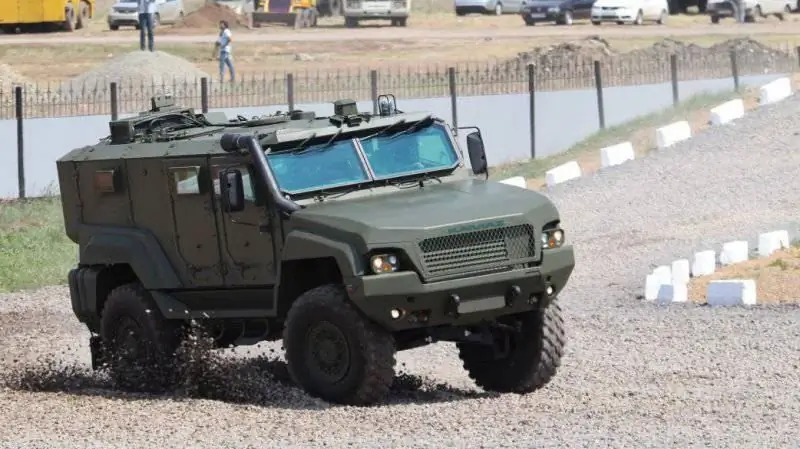
The KamAZ-53949 armored car is a protected vehicle with a 4x4 wheel arrangement and a body that protects against bullets and explosive devices. According to some reports, the machine is being developed as a platform on the basis of which modifications of equipment will be built for various customers. For example, the Ministry of Internal Affairs and the Ministry of Defense will be able to purchase armored cars in various configurations, with different characteristics and capabilities that meet customer requirements.
The KamAZ-53949 vehicle is being developed with extensive use of developments in the projects of armored vehicles of the Typhoon family, which are currently being implemented by the Kama Automobile Plant. For this reason, the new armored car is often called "Typhoonenk". In addition, the existence of the name "Patrol-A" is known. According to some reports, such a name was given to a modification of an armored car for the internal troops and the Ministry of Internal Affairs.
The KamAZ-53949 armored car must carry up to two tons of cargo or up to ten people, including the crew. This affected its size and weight. Machine length reaches 6.4 m, width - 2.5 m, height - 3.3 m. Clearance - 433 mm. The curb weight of the armored car is 13.7 tons, the total weight is 15.7 tons. The dimensions and weight of the vehicle are formed taking into account the requirements for cargo transported by military transport aircraft and helicopters. The armored car can be transported by Il-76, An-124 or Mi-26 helicopters.
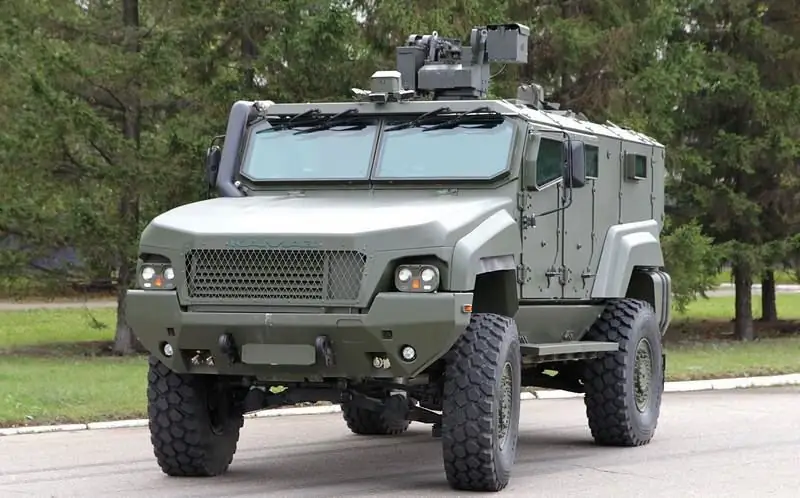
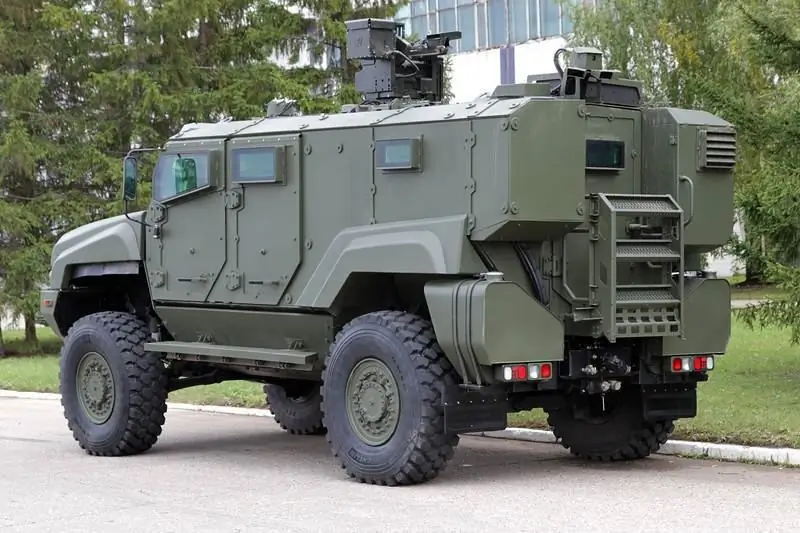
The machine is equipped with a van-type body with the placement of volumes, traditional for such equipment. In the front part, inside the hood-armored casing, there is an engine, and the rest of the volumes are given for the placement of the crew and troops or cargo. The hull complies with level 3 of the STANAG 4569 standard and protects the crew from the armor-piercing bullets of the 7.62x54R cartridge. It also provides protection against shrapnel from artillery shells or explosive devices.
The bottom of the hull has a special V-shape, designed to divert the blast wave away from the habitable volume. The possibility of rescuing the crew is declared when 3 kg of TNT are detonated under the wheel or any part of the bottom.
The hull provides a set of doors for embarkation and disembarkation of the crew and troops. In the sides of the hull there are four doors for the driver and three passengers, located in the front of the car. Another door is in the stern sheet. It should be used by the troops stationed at the rear of the vehicle. There are two hatches in the roof of the troop compartment. All doors are equipped with armored glass windows. To preserve internal volumes, glass blocks are placed on the outer surface of the case. In addition, there are two glasses in the sides of the troop compartment. The driver has a large windshield.
Under the hood of the KamAZ-53949 armored car there is an American-made Cummins 6ISBe 350 P-6 diesel engine with a capacity of 350 hp. The automatic transmission was supplied by the American company Allison. The chassis uses an independent hydropneumatic suspension with automatic wheel inflation. The vehicle is equipped with bulletproof tubeless tires of 14.00 R20 dimension. According to the available data, tires with holes should be able to travel at speeds of up to 50 km / h and allow to travel at least 50 km.
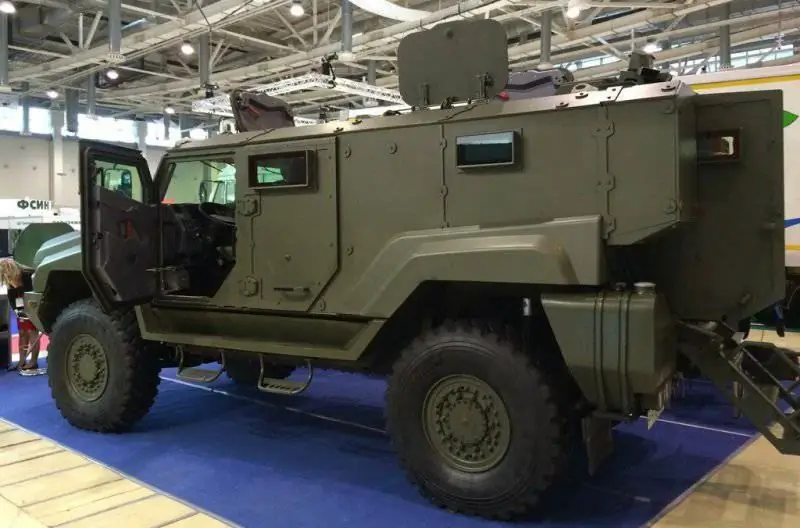
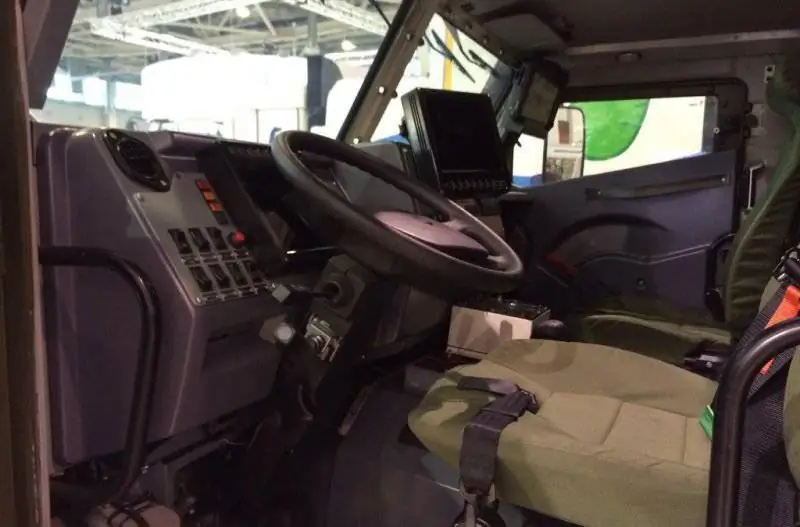
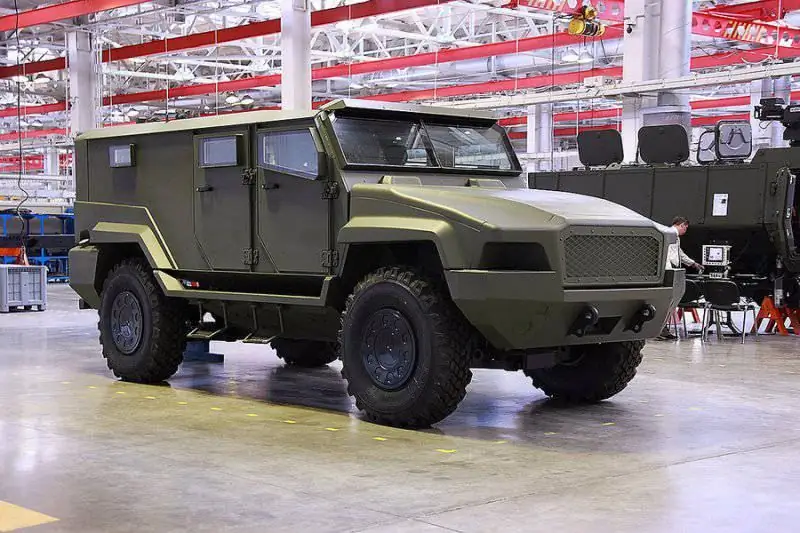
The armored car "Typhoonok" on the highway must reach speeds of up to 100 km / h. The cruising range, according to some sources, is at least 800-850 km.
Inside the vehicle's armored hull, there are ten seats for the crew and troops. To increase the level of protection, special "anti-mine" seats are used, which absorb part of the explosion energy under the car. In front of the habitable volume, the driver and commander are located. Behind them there are two more places for the paratroopers. Six seats are installed along the sides of the troop compartment. Due to the use of the V-shaped bottom of the hull, the paratroopers must sit facing each other. This landing allowed the use of a relatively narrow aft door.
The dashboard of the armored car is equipped, as they say, with the latest technology. Two liquid crystal displays are used to display information. One is located on the dashboard, above the steering column, the second is to the right of the steering wheel. At the same time, indicators and switches of the usual design are preserved on the board.
For the convenience of landing in a relatively high cabin, a set of steps is provided on the hull. In early photographs of the prototype armored car, there were steps of a characteristic frame structure under the side doors. Later images show that these have been replaced by wide folding steps. A ladder is hinged under the aft door. For embarkation and disembarkation, it must be lowered. At the same time, the design of the aft ladder raises certain questions. For example, it is not entirely clear how it is proposed to raise it after the crew and the landing party have landed in the car and to lower it during an emergency disembarkation. Perhaps the design provides for some mechanisms for raising and lowering the stairs, but there is no exact data on this yet.

On the roof of the hull, the KamAZ-53949 armored car has a seat for installing a remote-controlled combat module. The vehicle can be armed with various small arms, up to heavy machine guns and automatic grenade launchers. In its current state, the Typhoonok does not have embrasures for firing personal weapons. For self-defense and destruction of targets, apparently, it is proposed to use only the combat module.
To date, there is only one copy of the KamAZ-53949 armored car. This prototype is currently undergoing preliminary tests. In addition, another experimental armored car is being built in Naberezhnye Chelny, which will later join the tests. Any test results have yet to be released. Probably, the tests of the first prototype are at those stages when it is too early to summarize and draw conclusions.
It is known that the KamAZ-53949 armored car can be modified at the request of those or other structures wishing to order it. So, the ground forces require replacing the hydropneumatic suspension with a spring one, reducing the number of electronics, and also taking other measures to simplify the machine. The airborne troops, in turn, want to receive equipment with the ability to land from aircraft. At the request of other structures, other changes can be made to the design in order to bring the armored car in accordance with the customer's requirements.
While the first prototype of the Typhoonok / Patrol-A armored car is being tested, the project has encountered unexpected difficulties. One of the features of the proposed machine is such that under certain negative circumstances it can put an end to all work. The fact is that foreign components are widely used in the design of the KamAZ-53949 armored car. The engine and gearbox are sourced from the US, the suspension components are from Ireland and the mine-action seats are sourced from the UK. Even tubeless tires were purchased abroad, from the French company Michelin.
Thus, the further fate of the KamAZ-53949 project to a certain extent depends on the plans of the leadership of a number of foreign countries. Currently, against the backdrop of the Ukrainian crisis, some foreign countries have imposed sanctions on Russia. If Washington, London or Paris, in addition to the existing sanctions, decide to end any military-technical cooperation with Russian enterprises, then the new domestic armored car risks being left without some essential components.
According to available data, by now the Ministry of Industry and Trade and a number of specialized enterprises have prepared an action program aimed at replacing imported components in the new armored cars of the Kama Automobile Plant. The production of the necessary components and assemblies is planned to be launched in the near future. This news looks very optimistic, although it may give rise to questions. The use of new units, such as an engine or transmission, actually makes a new car with different characteristics from the base armored car, which must go through the entire cycle of testing and development. How it is planned to solve this problem is unknown.
In its current form, the KamAZ-53949 armored car looks quite interesting. According to the published data, it is a convenient multipurpose vehicle that is protected from small arms and explosive devices. This technique can be used in low-intensity conflict zones, as well as when performing various special operations. In addition, the possibility of creating various modifications of the base machine, adapted for operation in various structures, both in the army and in the units of the Ministry of Internal Affairs, looks like a big plus.
Nevertheless, do not forget that at the moment there is only one prototype of a promising armored car, which is being tested on polygon tracks. Until the calculated characteristics are verified and confirmed, it will be possible to make only approximate assumptions about the future fate of the development. The first phase of testing should be completed this year. Next, you will need to carry out a number of works, first of all, to correct the identified shortcomings. Serial production and deliveries of new armored cars are expected to be deployed by 2017-18. If the project does not face serious technical or political difficulties, then such a time frame looks quite real. If it is necessary to carry out a set of work to replace imported components, then the timing of the completion of the project and the start of operation of serial equipment may noticeably shift to the right.






